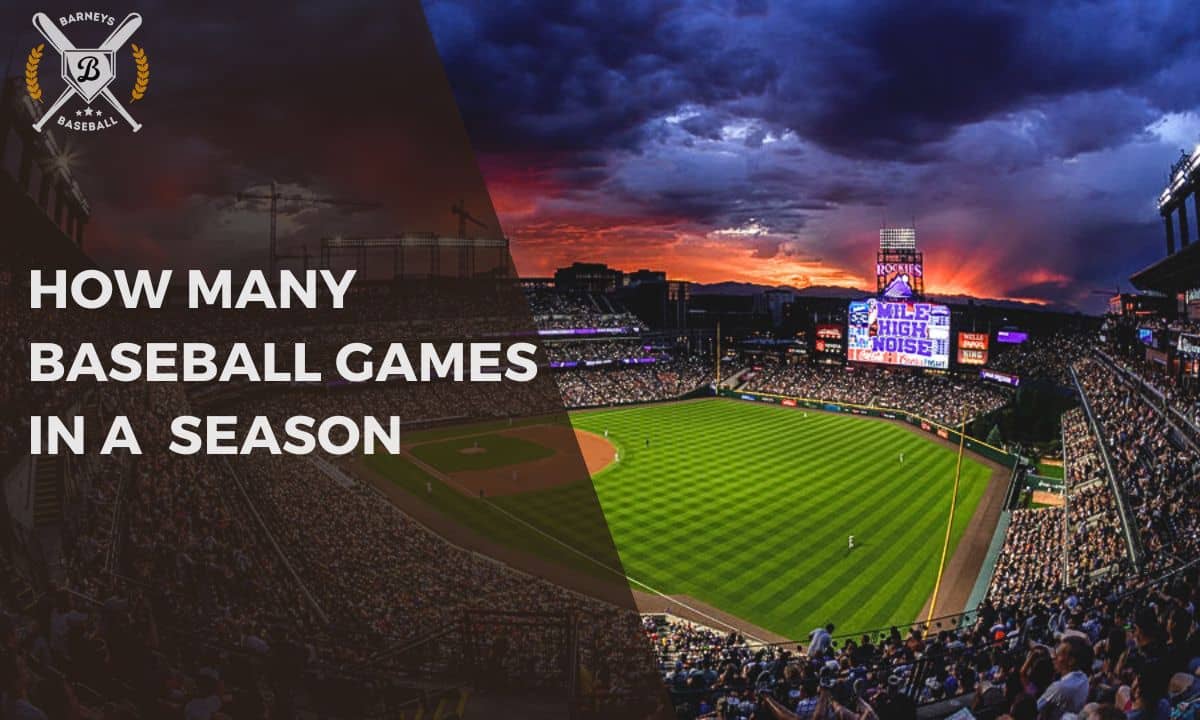1. In Major League Baseball (MLB), a regular season consists of 162 games for each team.
“How many baseball games in a season” This structure allows teams to compete against one another, contributing to the determination of playoff contenders and ultimately the World Series participants.
The number of games can vary in other baseball leagues or levels, but the MLB’s 162-game schedule is a well-known standard.

What is a baseball season?
- The time frame for which professional or amateur baseball teams play a set of planned games is referred to as the baseball season. Each team in Major League Baseball (MLB) plays a set number of games against other teams in the league throughout the regular season, which normally runs from early spring to late summer.
These games’ results influence the team rankings, which determine which teams advance to the postseason playoffs.
The season culminates with the World Series, where the champions of the respective leagues compete for the ultimate title in baseball. The structure and duration of a baseball season may vary in different leagues and levels of play.
Importance of Knowing the Number of Baseball Games in a Season
- The 162-game regular season in Major League Baseball (MLB) is divided into two main parts:
In addition to playing against teams in their own league (the American League or the National League), teams from other divisions in the same league as well as occasionally clubs from the opposing league also meet each other during interleague play.
The longer schedule makes it possible to evaluate each team’s total performance in greater detail, accounting for things like player durability, consistency, and flexibility throughout the season.
Over the course of these 162 games, the clubs rack up wins and losses, and their records define where they stand in their different divisions and leagues.
At the end of the regular season, the teams with the best records qualify for the postseason, where they compete in a series of playoff rounds leading to the World Series. The 162-game structure has become a hallmark of MLB, providing fans with a lengthy and exciting baseball season filled with rivalries, milestones, and the pursuit of a championship.
Related: How to break in a baseball glove-7 Best Step
Why does the MLB play so many games?
- In order to provide a thorough and impartial assessment of every team’s performance, the MLB plays a 162-game regular season.
With consideration for variables like individual consistency, flexibility, and team dynamics, the long schedule makes it possible to identify the top teams in the league with greater accuracy. An accurate picture of a team’s competence and competitiveness is ultimately produced by the huge sample size and the reduction of short-term swings that come with playing a lot of games.
Additionally, this model keeps fans interested for a large part of the year, creating a sense of excitement and expectation as teams advance through the regular season, leading to the postseason and, eventually, the World Series.
A season-long story is also developed by the lengthy timetable, which encourages fan interaction and sustains attention for a considerable amount of time.
The perseverance needed to win in a 162-game season emphasizes the fortitude and reliability required to succeed in one of the most competitive professional sports leagues.
The MLB regular season is a thorough and engrossing spectacle because the format strikes a balance between statistical relevance, competitive integrity, and fan involvement.
Why is baseball season so long?
To take advantage of baseball’s post-war surge in popularity and pay the owners back for the sacrifices made to the players, including pension benefits, a 168-game schedule (8 teams playing 24 games against each other) was arranged.

But strong public and player resistance doomed the plan, and at a September 1946 meeting, the majors opted to stick with the 154-game schedule. Boston’s Tom Yawkey was credited with persuading the owners to abandon the MacPhail plan.
What Team Has Had The Most Wins In MLB History?
- In Major League Baseball (MLB) history, the San Francisco Giants hold the record for most victories.
The Giants have won more than 11,000 games in their franchise history, as of my most recent knowledge update from January 2022. Success is ascribed to the team’s legendary history, which spans both its New York and current incarnations in San Francisco.
As one of the most successful teams in MLB history, the Giants’ accomplishment highlights their enduring performance and competitiveness over the years. Keep in mind that win totals are subject to change with each season, so it’s best to consult the most recent statistics for the most recent data.

How many innings do you need to win in MLB?
- Being ahead of the other club in points at the end of the game, which lasts nine innings, is the main goal of Major League Baseball (MLB).
The top half and the bottom half are the additional divisions made for each inning. Every half-inning, one team positions itself on the field to play defense and the other team plays offense to try and score runs.
At the end of nine innings, a team needs to score more runs than the other team in order to win. But extra innings are played to decide a winner if a game is deadlocked after nine innings.
The focus on scoring runs rather than meeting a set number of innings adds excitement and strategy to the game, making every game a competitive and dynamic affair.
Related: Best Guide About-How many stitches are on a baseball
What sport has the longest season?
- One of the longest seasons in professional hockey is found in ice hockey.
The National Hockey League (NHL), which is well-known for its demanding and long schedule, offers a taxing competition that lasts for about nine months. With each of the 32 clubs playing an 82-game schedule, the NHL season normally begins in early October and runs through the regular season until April.
The physical demands of ice hockey, which is renowned for its fast-paced, hard-hitting style, further intensify the rivalry. The NHL playoffs, which consist of a series of best-of-seven elimination rounds and span two months, begin after the regular season ends. f sports.
How can teams play fewer than 162 games?
- Due to a number of situations covered by the league’s rules and regulations, Major League Baseball (MLB) teams may play fewer than 162 games.
Rainouts and unfavorable weather conditions are a major contributing element. A game may be postponed if unfavorable weather, such as persistent rain or snow, makes playing conditions unsafe or impracticable.
In such cases, clubs are compelled to reschedule the match for a later time, frequently as a doubleheader or on a regular off-day. Furthermore, circumstances unrelated to weather, such crises or unanticipated events, may sometimes cause games to be canceled or postponed.
Doubleheader scheduling is another reason why some teams play fewer than 162 games. A doubleheader is when the same two teams play two games on the same day.
A team’s regular season schedule usually includes these, or they are arranged as a make-up for games that were postponed. Though it contributes to the season’s overall number of games played, it’s crucial to remember that each doubleheader counts as one game in the standings, meaning the team plays two games on that specific day.
Why so many games?
- Major League Baseball (MLB) decided to implement a 162-game regular season based on a mix of historical development, competitive integrity, and financial concerns.
A key component of the sport, the extended season, which runs from spring to late summer, is a custom that has developed throughout time. The long schedule is primarily justified by the need to guarantee a thorough assessment of every team’s performance.
As a sport, baseball requires a lot of moving parts, like player injuries, form changes, and pitching rotations. Teams who play a lot of games get more chances to show off their abilities, and short-term swings or statistical oddities have less of an effect on the standings as a whole.

Moreover, baseball’s statistical character is tightly associated with the 162-game model. A longer season offers a more dependable sample size for assessing player and team performance in a sport where individual and team statistics are highly valued.
The regular season results are a better indicator of the teams’ overall ability levels because of their statistical robustness, which is essential for assessing a team’s genuine potential.
How many baseball games in a season of International Baseball?
- International Baseball adds an awesome global vibe to the baseball scene, showcasing how the love for the game spans across the world with its diverse playing styles.
Picture this: from the exciting Little League World Series that brings together young talents from all corners to the pro leagues in Asia, Europe, and Latin America—International Baseball is a melting pot of competition.

Players from different parts of the globe bring their own flair to the sport, creating this vibrant mix. And when nations unite for events like the World Baseball Classic, it’s not just about the game;
It’s like a cultural exchange where fans can cheer for their local heroes and also appreciate the cool variety that baseball offers on a worldwide scale.
International Baseball isn’t just hitting balls and running bases; it’s a global celebration of talent, cultures, and the universal joy that baseball brings to fans everywhere.
Conclusion
In wrapping up, delving into the various factors influencing the number of baseball games reveals the intricate dynamics that shape this beloved sport.
Whether it’s league rules, player well-being, broadcasting, or historical traditions, each element plays a pivotal role in crafting the season’s structure.
The delicate balance between honoring the sport’s rich history, ensuring fair competition, and adapting to contemporary trends underscores the nuanced decisions behind the season’s length.
As baseball continues to evolve, these considerations reflect a blend of tradition, innovation, and the collective interests of players, fans, and stakeholders.

